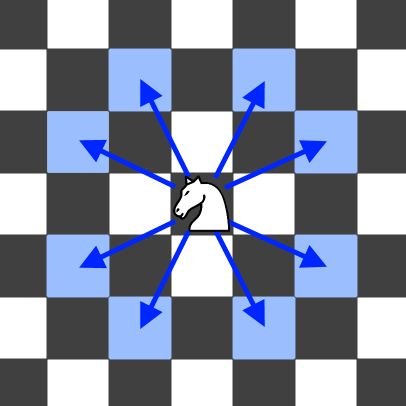
g0601_0700.s0688_knight_probability_in_chessboard.readme.md Maven / Gradle / Ivy
Go to download
Show more of this group Show more artifacts with this name
Show all versions of leetcode-in-java Show documentation
Show all versions of leetcode-in-java Show documentation
Java-based LeetCode algorithm problem solutions, regularly updated
The newest version!
688\. Knight Probability in Chessboard
Medium
On an `n x n` chessboard, a knight starts at the cell `(row, column)` and attempts to make exactly `k` moves. The rows and columns are **0-indexed**, so the top-left cell is `(0, 0)`, and the bottom-right cell is `(n - 1, n - 1)`.
A chess knight has eight possible moves it can make, as illustrated below. Each move is two cells in a cardinal direction, then one cell in an orthogonal direction.

Each time the knight is to move, it chooses one of eight possible moves uniformly at random (even if the piece would go off the chessboard) and moves there.
The knight continues moving until it has made exactly `k` moves or has moved off the chessboard.
Return _the probability that the knight remains on the board after it has stopped moving_.
**Example 1:**
**Input:** n = 3, k = 2, row = 0, column = 0
**Output:** 0.06250
**Explanation:** There are two moves (to (1,2), (2,1)) that will keep the knight on the board. From each of those positions, there are also two moves that will keep the knight on the board. The total probability the knight stays on the board is 0.0625.
**Example 2:**
**Input:** n = 1, k = 0, row = 0, column = 0
**Output:** 1.00000
**Constraints:**
* `1 <= n <= 25`
* `0 <= k <= 100`
* `0 <= row, column <= n`© 2015 - 2024 Weber Informatics LLC | Privacy Policy